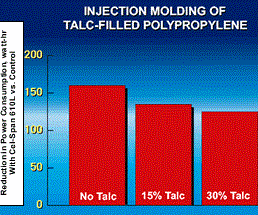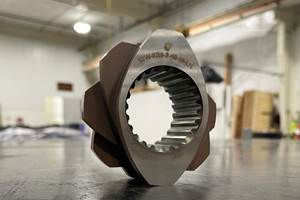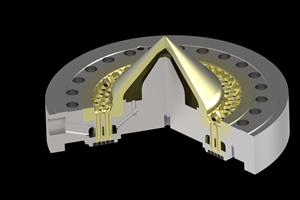Novel Processing Aids Ease Flow Of a Wide Range of Plastics
A new family of processing-aid masterbatches is said to enhance the processability of a wider range of plastics than is possible with other additives.
A new family of processing-aid masterbatches is said to enhance the processability of a wider range of plastics than is possible with other additives. Based on unique chemistry (patent pending), these products reportedly provide dramatic improvements in injection molding cycle times and extrusion rates.
Sold under the Cell-Span name, they are produced by Phoenix Plastics of Conroe, Texas, a custom compounder and supplier of specialty additive masterbatches. Cell-Span was developed in concert with Stabilization Technologies, a consulting firm in Charlotte, N.C., headed by Joseph R. Webster, a well-known expert in additives chemistry for plastics and fibers.
Significant cost savings
Seven Cell-Span formulations, all sharing a similar base chemistry, are tailored for use in various plastics ranging from polyolefins, PS, and PVC to ABS, PC, PET, PBT, and nylons. Says Webster, "We have found a new home for existing chemistries not typically used in plastics. These "supramolecular" chemistries allow formation of directional hydrogen bonds that emulate the stronger covalent bonds."
According to Webster, these additive masterbatches can replace existing processing aids and lubricants, such as metallic stearates, amides, and fatty acid derivatives used in polyolefins and the styrenics and waxes used in PVC. Cell-Span can also replace some primary and secondary antioxidants and nucleating agents, according to Webster.
The new additives are said to be very cost-competitive and have been shown in extensive field tests to provide significant cost savings. The masterbatches contain 20% active ingredient and are used at typical letdown levels of 0.2% to 1%, compared with 1% to 3% for many conventional additives.
- HDPE: In one trial, use of Cell-Span 610 in molding 2-lb, green-pigmented HDPE pails cut cycle time by 5 sec, a 25% reduction. Part cost was reduced from $1.52 to $1.45, a savings of $2509.44 per month after accounting for the cost of the additive..
- Unfilled PP homopolymer: Cell-Span 610L in a 61-g, pigmented PP part resulted in a 10-sec drop in cycle time—a 36% reduction—and cost savings of $4166.77 per month.
- Talc-filled PP homopolymer: The addition of 610L to a 3-lb, 30% talc-filled part molded on a 750-ton machine reduced cycle time from 83 to 52 sec, or 37% (see graph). Cycle time for a 15% talc-filled part went from 76 sec to 52 sec (-31%).
- PP random copolymer: Cell-Span 610 in a 1.2-lb pigmented part reduced cycle time by 13 sec, or 17%, at a monthly cost saving of $700.
- 30% glass-filled PP: Cell-Span 610L reduced cycle time 36% to 80 sec, saving the molder $1,026/day and $30,805/month.
- Foamed PP: Unfilled, pigmented PP experienced sink marks, despite the use of an endothermic blowing agent. By adding 610L, flow was increased and sinks disappeared (see photo).
- Flexible PVC: Cell-Span 605 in a molded flexible PVC part allowed processing temperature to be reduced from 320-330 F to 230-250 F, and cycle time was 6 sec shorter.
- Rigid PVC: Cell-Span 608 in a rigid PVC extruded profile reduced extruder load from 52 amps at 18 rpm and 305-365 F down to 39A at 26 rpm and 205-300 F. This upped the output rate 63% to 538 lb/hr from 330 lb/hr.
- PS: Grade 610 in a 1.5-lb pigmented part reduced cycle time by 25 sec, or 45%, thereby saving $6922/mo.
- ABS: Cell-Span 610L in a 2.5-lb pigmented part reduced cycle time by 16 sec, or 23%, on a 500-ton molding machine, partly by allowing the hot runner’s temperature to be cut from 490 F to 450 F.
- Addition of Celspan 610L to ABS on a 750-ton injection press allowed a 10-sec, or 17%, reduction in cycle time for a 2.5-lb part in a six-cavity mold.
- Polycarbonate: Grade 606 in a 1.3-lb, pigmented part resulted in a cycle-time reduction of 23 sec, or 30%. This translated into monthly savings of $3752 and lowered the piece price 10%.
- Nylons: Various grades of Cell-Span in injection molded nylon 6, 66, and other nylons have allowed molding temperatures to be reduced by 18° to 45° F while reducing cycle times by 20 to 35 sec in both natural and glass-filled systems.
Related Content
Green’s the Theme in Extrusion/Compounding
The drive toward circular economy is requiring processors to make more use of PCR. Machine builders at K—across all extrusion processes—will be highlighting innovations to help them do just that.
Read MoreHow to Configure Your Twin-Screw Extruder: Part 3
The melting mechanism in a twin-screw extruder is quite different from that of a single screw. Design of the melting section affects how the material is melted, as well as melt temperature and quality.
Read MoreConfiguring the Twin Screw Extruder: Part 4
For many compounding operations, material is fed to the extruder at the feed throat. This is the case when feeding a single polymer or a blend of polymers mixed with solid additives. Some ingredients, however, present a challenge in feeding. Here’s how to solve to them.
Read MoreHow to Maintain Pelletizing Quality When Acid Attacks
Developments in the chemistry of polymers and additives have made corrosion a real problem in pelletizers. Here’s how to ward it off.
Read MoreRead Next
Why (and What) You Need to Dry
Other than polyolefins, almost every other polymer exhibits some level of polarity and therefore can absorb a certain amount of moisture from the atmosphere. Here’s a look at some of these materials, and what needs to be done to dry them.
Read MoreLead the Conversation, Change the Conversation
Coverage of single-use plastics can be both misleading and demoralizing. Here are 10 tips for changing the perception of the plastics industry at your company and in your community.
Read MorePeople 4.0 – How to Get Buy-In from Your Staff for Industry 4.0 Systems
Implementing a production monitoring system as the foundation of a ‘smart factory’ is about integrating people with new technology as much as it is about integrating machines and computers. Here are tips from a company that has gone through the process.
Read More



.%20Addition%20of%20Cell-Span%20in%20the%20hopper%20increased%20flow%20and%20eliminated%20sinks.jpg;width=700;quality=80)














.png;maxWidth=300;quality=90)








